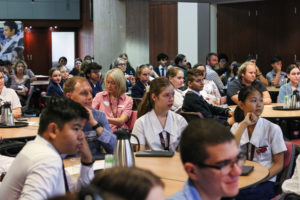Queensland primary and high school students explored the limits of science and technology at recent Griffith University Science on the GO! conference and challenge days.
More than 160 students and teachers from 28 South East Queensland schools attended a Science on the GO! STEM Ambassador Conference at Parliament House, while about 500 kids and 50 high school STEM ambassadors took part in Primary Science and Engineering Discovery Days, held in partnership with Inland Rail, at Logan.
Griffith Sciences STEM Outreach Manager Sally McPhee said the Ambassador conference aimed to foster future STEM leaders, with Griffith Enterprise Innovation Manager Hunter Walkenhorst taking the high school students through leadership training in the form of a design thinking workshop.
“It takes students through the process of identifying problems and designing solutions using 21st century STEM skills,” Ms McPhee said.

The STEM Ambassadors spent time working on STEM Action Plans for implementation in their schools.
“Students then started the process of creating a tailor-made STEM Action Plan, that they will present to their principal for implementation at their individual schools.”
Through the Action Plan, students develop strategies that will best work in their school communities to get their peers more engaged with STEM at their school.
This year, high school STEM ambassadors in Logan had an opportunity to deliver the Science and Engineering Challenge events to their juniors, with 2021 the first time Science on the GO! has held this event for primary school students.
“I’ve had lots of fun helping the Year Sixes…get excited about Science, Technology, Engineering and Maths and hopefully encourage them to pursue careers in this field in the future,” Park Ridge State High School STEM ambassador Sana Jabare said.
Students got a taste of careers like civil and biomedical engineering, architecture and renewable energy systems design, with experiments like constructing shelters to withstand earthquakes, creating a bionic hand out of craft items, and balancing energy needs for a city to avoid blackouts
“We know that skills like problem solving, critical thinking, teamwork skills — all skills students get through a STEM degree — are really essential in ensuring that young people today have for the jobs of the future,” Ms McPhee said.
“The whole idea is that kids get inspired to continue to study Science and have a career in STEM.”
“We have a lot of students say things to us like, ‘Oh, I didn’t know that’s what engineering is, my uncle’s an engineer, but I never knew it was this fun.’
“These activities are really interactive and hands on, which we know is the gold standard for communication science and applying complex theories.
“We’ve seen these days actually change students perception about science, their ability and the future career they see themselves in.
“By giving students exposure and experience to future careers and providing a clear academic pathway, we’re able to guide them on a journey that hopefully arrives at a future STEM career.”

